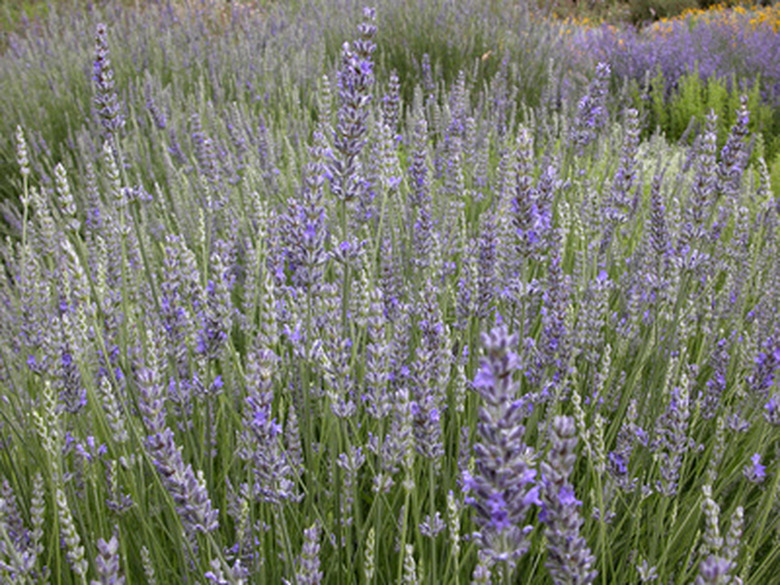Lavender Plant Varieties
Lavender is a perennial native to the Mediterranean region, and as such, all lavenders require full sun, very well-drained soils, very little fertilization and only moderate amounts of water. Prized for its strong essential oils and attractive spikes of purple flowers, lavender has long been used in medicines, cosmetics, cooking and for simple aromatics. Most lavender varieties are cultivars of two species, Lavandula angustifolia (English lavender) and Lavandula x intermedia (lavender hybrid of angustifolia and latifolia), and over 400 separate varieties exist.
L. angustifolia ‘Gray Lady’
Individual plants grow to between 2 and 3 feet, producing short spikes of light blue flowers. 'Gray Lady' flowers are excellent for drying. Like other angustifolia and x intermedia lavender varieties, Gray Lady is hardy to Zone 5 or 6 but will not tolerate the hot and humid areas south of Zone 9.
L. angustifolia ‘Hidcote’
One of the most popular lavender varieties, 'Hidcote' is a relatively compact, slow-maturing variety, usually growing to about 2 feet tall. Plants have narrow, silver-green leaves and dark purple flower spikes. Flowers appear from June to August.
- Lavender is a perennial native to the Mediterranean region, and as such, all lavenders require full sun, very well-drained soils, very little fertilization and only moderate amounts of water.
L. angustifolia ‘Lady’
Most lavender hybrids produced from seed do not grow true to type, meaning they retain few characteristics from the parents; 'Lady' is one of the few lavender varieties that grow true from seed. It was voted an All-American Selection plant in 1994. Lavender-colored flowers appear earlier than most, and plants are short, growing from 8 to 10 inches high.
L. angustifolia ‘Munstead’
Another popular variety, 'Munstead' lavender is an early bloomer, putting on spikes of light to dark purple flowers in late May. Plants grow to between 1 and 2 feet tall, though flower spikes temporarily increase the plant's overall height.
L. angustifolia ‘Nana Alba’
A short-statured lavender, 'Nana Alba' reaches only 1 foot in height, putting on very short spikes of white flowers in early summer. Because of its size, this variety is exceptionally well-suited for container gardening.
- Most lavender hybrids produced from seed do not grow true to type, meaning they retain few characteristics from the parents; 'Lady' is one of the few lavender varieties that grow true from seed.
- Another popular variety, 'Munstead' lavender is an early bloomer, putting on spikes of light to dark purple flowers in late May.
- Plants grow to between 1 and 2 feet tall, though flower spikes temporarily increase the plant's overall height.
L. angustifolia ‘Rosea’
As the name implies, 'Rosea' is one of the few pink-flowered lavender varieties. Plants grow between 1 and 2 feet tall, sending up shoots of light-pink flower spikes in early summer. 'Hidcote Pink' and 'Jean Davis' are other pink-flowered forms.
L. x intermedia ‘Grosso’
One of the largest lavender hybrids, 'Grosso' is one of the main commercial varieties used in soaps and cosmetics. Specimens grow to 3 feet tall and wide, producing 3-foot-tall spikes of strongly scented dark lavender-blue flowers in summer.
L. x intermedia ‘Grappenhall’
Even larger than 'Grosso' is the giant 'Grappenhall', a massive, 4-foot-tall variety well-suited to hedging. Individual plants grow to 3 feet wide and produce light-purple lavender flowers in early summer.
- As the name implies, 'Rosea' is one of the few pink-flowered lavender varieties.
- Specimens grow to 3 feet tall and wide, producing 3-foot-tall spikes of strongly scented dark lavender-blue flowers in summer.
L. x intermedia ‘Provence’
Growing to 3 feet tall and 2 feet wide, 'Provence' is named for the region in France where it is grown commercially. Delicately scented lavender-blue flowers appear on 2-foot spikes in mid-summer. Provence is less hardy than other lavenders and will not withstand low winter temperatures north of USDA Zone 6.
L. x intermedia ‘Twickel Purple’
One of the hardiest English varieties, 'Twickel Purple' grows to between 2 and 3 feet high and wide and bears broad gray-green leaves. Deep-purple flowers appear on 2-foot spikes in early summer. This variety is excellent for hedges.
